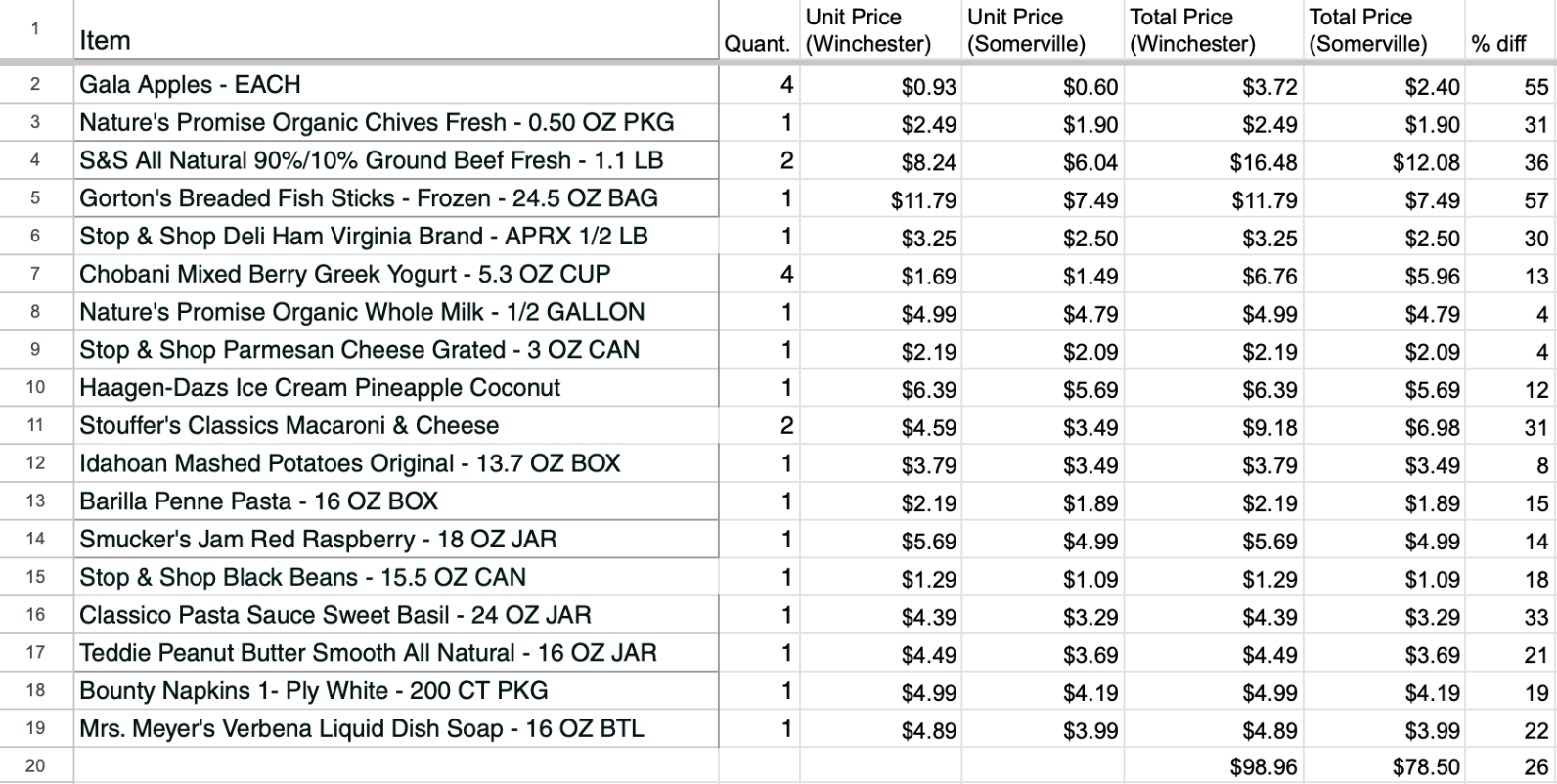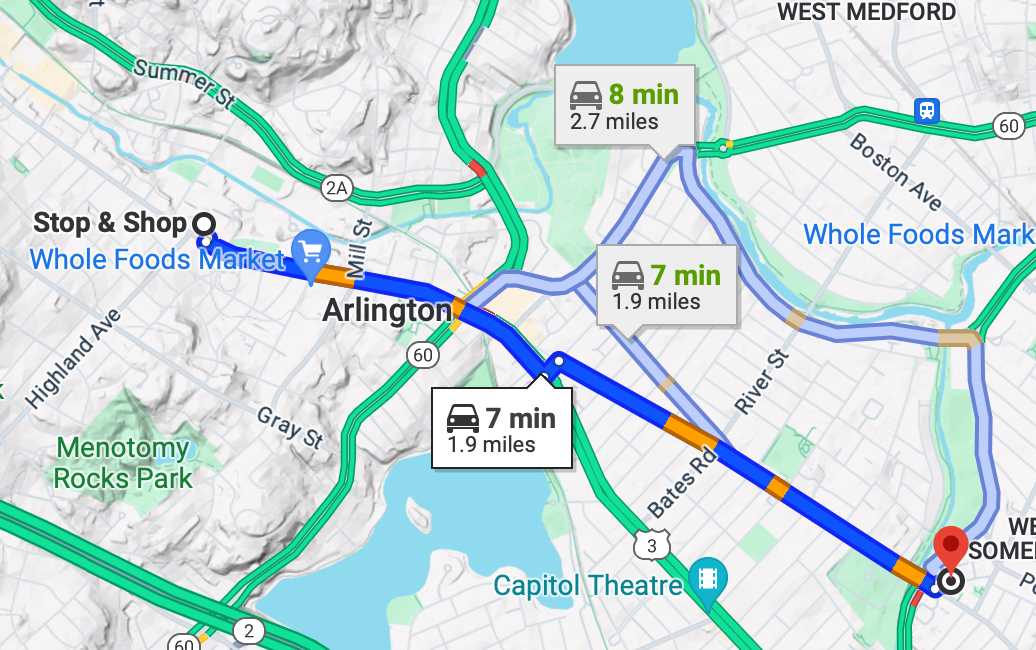Are You Overpaying for Groceries Due to Zone Pricing?
02/05/24 • 5 minute read
While I'm usually spending my time comparing prices on running shoes on this site, I recently found myself comparing prices on something else by accident: I found a 20% difference in the cost of groceries from the same chain of stores 2 miles apart.
I live just outside of Boston in Medford, a city that straddles the transition between urban and suburban neighborhoods. The grocery chain I usually shop at, Stop & Shop, has two stores about equidistant from my house: one in the affluent suburban city of Winchester to the north, and one in the more hip & urban city of Somerville, to the south. (There's also one in Medford itself, but is actually further away from me than the others).
I often shop online for pickup and will choose which store I go to based on which one works better with my plans on any given day. The other day, after filling a cart with groceries, I changed my mind about which store I wanted to pick up at. I switched from the Winchester store to the Somerville store, and to my surprise: the price of my cart shrank from about $140 to $120.
I switched from the Winchester store to the Somerville store, and to my surprise: the price of my cart shrank from about $140 to $120
I started working through the grocery list item-by-item and was amazed by what I saw. Though a couple of the prices were the same, I found item after item that was cheaper in the Somerville store. Some by as little as $.10, some by far more–but the pattern was clear. Not a single item was more expensive in Somerville, and those little price changes added up to a big difference in total cost.
After completing my purchase, I decided to take a deeper dive with side-by-side carts for a comparison. In this post I'll break down the price differences I found at my local stores and what I learned about grocery pricing practice in general.
Preface
Before we get into the numbers, I want to clarify that this post is written to help people make more informed decisions about their grocery shopping. It is not intended to call out Stop & Shop or imply any sort of wrongdoing. It's common practice and no secret that prices can vary from store to store, even within the same chain. However, I was not aware the extent to which it was happening with stores I shop at everyday. I'm providing this information so that people can make better decisions about their own grocery shopping.
Furthermore, I will be upfront in stating that in the example cart below, I intentionally chose some products that had high price discrepancies in order to illustrate the differences. In other words, some examples are "cherry-picked". I am not making a claim of a specific, systematic savings number from one store over the other. Nevertheless, the products in the example are typical items one might pick up on a shopping trip and illustrate the range of significant price differences on a product-by-product basis.
The Numbers: a 20% Difference in Prices
To get a better feel for the differences in pricing between the two stores, I put together two side-by-side carts (using incognito browser windows). I chose 18 different items that wouldn't be out of place in a typical trip to the grocery store.
The result? A total price of $98.98 at the Winchester store, and $78.50 at the Somerville store. That's a difference of $20.46, or a premium of 26% over the Somerville store pricing at Winchester.

As mentioned earlier, some products were picked specifically because they demonstrated large price differences. For example, the largest price discrepancy in this list is a 24.5oz bag of frozen Gorton's Fish Sticks: $11.79 in Winchester and $7.49 in Somerville, a whopping 57% difference. This product came to serve as my Stop & Shop pricing bellwether.
Though items were marked up consistently across many product areas, there were a couple of patterns. Broadly speaking, the categories featuring some of the more dramatic price differences were: meat & seafood (both fresh & frozen) & produce. Sale items, on the other hand were almost always identical at the two stores. Presumably this is because of weekly flyers and advertising that targets multiple stores in the region.
While this shopping cart was made specifically to illustrate the price difference and may not reflect the exact savings one could see by switching stores, it is not too far off from the differences I observed in my actual cart–somewhere around a 20% in the cost of groceries depending on which way I turn when I leave my house.
What the Heck is Zone Pricing?
After seeing the dramatic difference in pricing between the two stores, I started to dig around the at other locations. The Somerville location has another Stop & Shop even closer than the Winchester location–a location just 1.9 miles away in neighboring Arlington, another affluent town. Not surprisingly, the Arlington Stop & Shop had the same high pricing as the Winchester location. Meanwhile, the Stop & Shop location I mentioned earlier in Medford? It followed the same lower pricing as the one in Somerville.

The pricing strategy is known as "zone pricing" and is a common practice in the grocery store industry. The differences in pricing are driven not by the cost of the goods, but by the consumer's willingness to pay & access to other alternatives. Based on the limited set of items in my cart and an informal check of other stores in my area, I identified exactly two pricing zones in surrounding towns. You either live in a $11.79-fish-stick town or a $7.49-fish-stick town–there was no middle ground (looking outside of my local region, in Connecticut, I did find other prices in the middle).
The differences in pricing are driven not by the cost of the goods, but by the consumer's willingness to pay & access to other alternatives.
While the Winchester/Arlington vs. Somerville example shows the more affluent and suburban towns receiving higher pricing (and thus perhaps less sympathy from readers), it's not always the case. Earlier this year a group of teenagers in Boston noticed similar pricing disparities between their local urban Jamaica Plain Stop & Shop (a $11.79-fish-stick store) and one in more affluent Dedham (a $7.49-fish-stick store). Similarly, higher pricing is found in Allston, an urban neighborhood known for its large student population.
It's hard to ignore questions of food equity in examples like these–a 2021 study identified Jamaica Plain as a "food desert" with limited access to healthy foods and grocery stores in general. Does zone pricing take advantage of the lack of food availability in these neighborhoods? While I won't assume any particular intent, on some level, the answer is plainly "yes". With fewer grocery options, people have no choice but to pay more.
Conclusion: Shop Around
While the pricing strategies used by Stop & Shop (or any other grocery chain) is opaque and difficult to predict on a store by store basis, one thing is very clear: the prices do vary greatly from location to location, even just a couple miles apart. And while I noticed this phenomenon at Stop & Shop, it applies to just about any grocery chain.
The takeaway, practical advice for getting the best price on groceries:
- be savvy to the practice of zone pricing
- check pricing at nearby stores by filling a cart online and switching locations
- take advantage of sale items each week, which tend to be more similarly priced
Meanwhile, if you need to compare prices on running shoes, that we can help you with right here.

